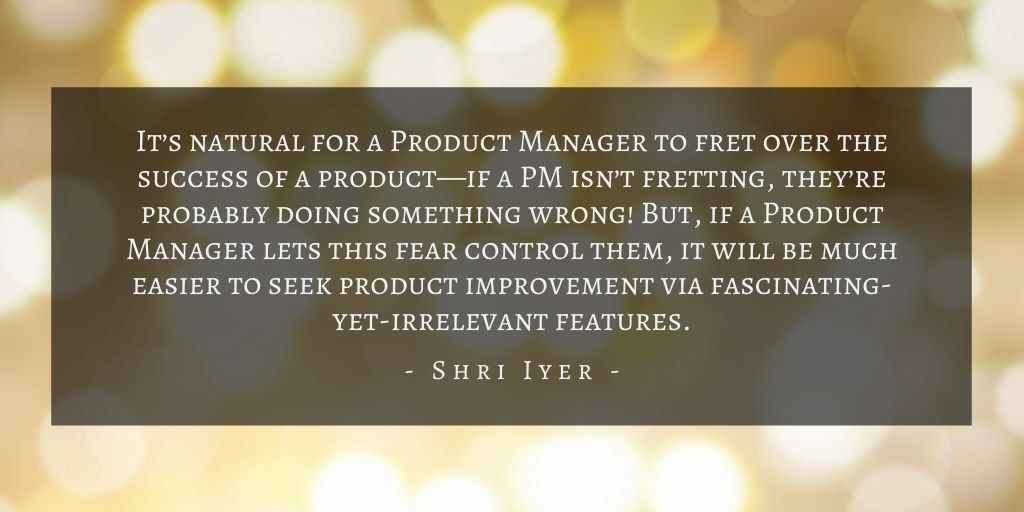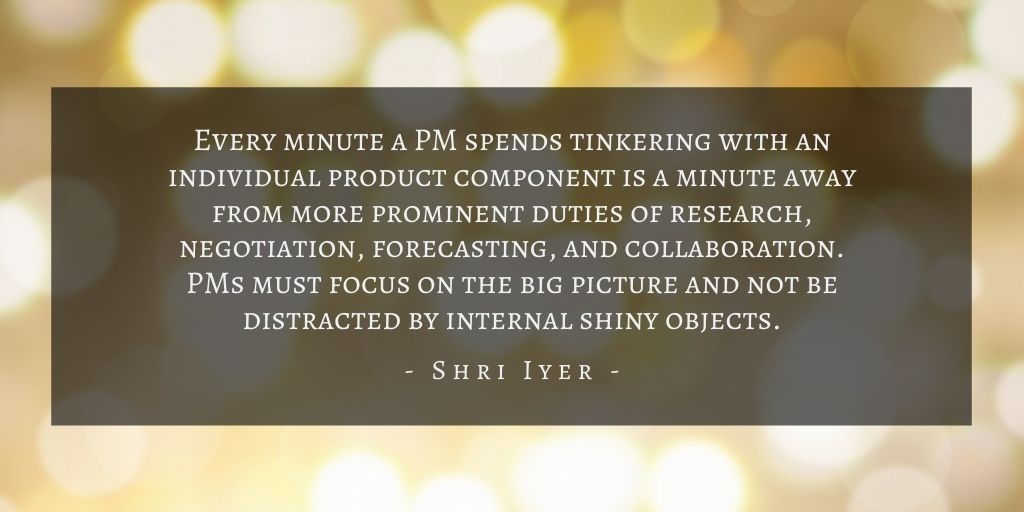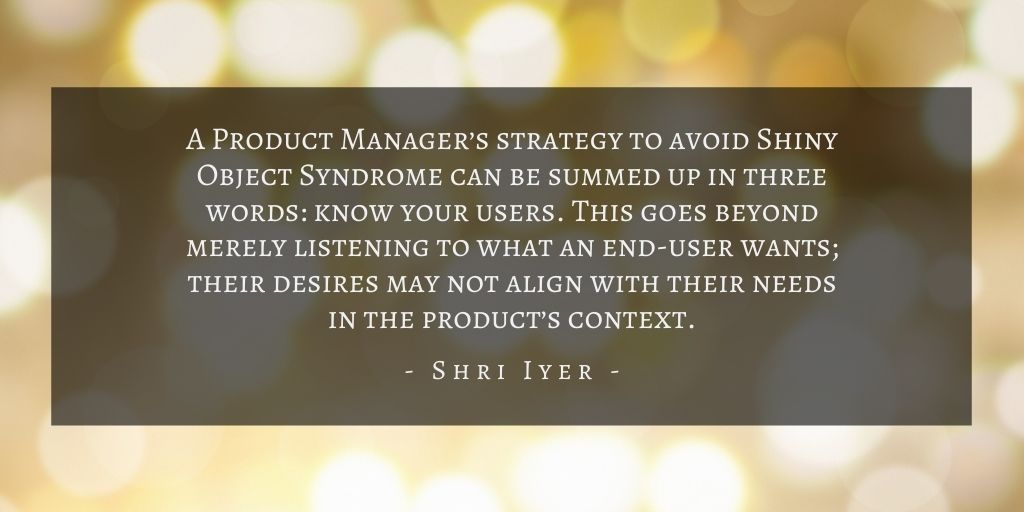Distractions abound in the world of Product Management, and it’s easy to see why. As Product Managers (PMs) jump from team-to-team, gauge user experiences, and fine-tune a hardware or software product, each moving part of the process creates room for outside influences to leak in. This phenomenon is known in various circles as “Shiny Object Syndrome.” And, for the sake of argument, it can be a Product Manager’s worst enemy. These “Shiny Objects” might be new hardware and software features that have hit the market, prototypes, or other elements that seem great to stakeholders, but fail to create value for products or users.
DoubleLoop founder Daniel Schmidt likens Shiny Object Syndrome (SOS) to a child’s attention span. In his article for Medium, Daniel explains that until children grow and gain endogenous attention, their focus jumps from task to task as flashy sights and enticing smells bombard their senses. For PMs, those distractions may not be as colorful as action figures or stuffed animals, but they still use their siren songs to draw unsuspecting individuals off-course.
Why Does Shiny Object Syndrome Happen?
Products aren’t created overnight. The product roadmap makes that clear from the start, and while reaching small milestones can be rewarding, sometimes the prospect of waiting for progress is enough to let the mind wander—and let the mind get distracted.

Proficientz created a list of common, diagnosable “symptoms” of SOS, including struggles to scale and overly-competitive business politics. One major cause of SOS that Proficientz brings up is “cool new technology,” shiny gadgets and lines of code that mesmerize Product Managers, Engineers, Sales and Marketing but provide empty, sometimes even negative value to a product or service.
The symptoms notwithstanding, Proficientz further whittles SOS down to one root cause:
“A perception that the current product pipeline isn’t addressing market needs significant enough to advance the company’s agenda in differentiating fashion.”
Is the team’s current product good enough? Are the prototypes allowing for complete exploration of the breadth and depth of capabilities? It’s natural for a Product Manager to fret over the success of a product—if a PM isn’t fretting, they’re probably doing something wrong! But, if a Product Manager lets this fear control them, it will be much easier to seek product improvement via fascinating-yet-irrelevant features. When this happens, it can result in unfinished projects, missed deadlines, deviation from the product roadmap and lower customer satisfaction.
How Does Shiny Object Syndrome Impact Teams?
When PMs get distracted, it usually means they are trying to branch out and take on new, unique tasks to add value to their products and professional endeavors. While it’s admirable, it is also detrimental to the product itself. Every minute a PM spends tinkering with an individual product component is a minute away from more prominent duties of research, negotiation, forecasting, and collaboration. PMs must focus on the big picture and not be distracted by internal shiny objects. Alpha Founder and VP of Product Nis Frome puts it best: “Product Managers should leave technical work such as coding to the engineering teams.”

PMs have to worry about external distractions, too. New tech and software peddled by the media as “the greatest thing since sliced bread” are like billboards and exit signs along the product roadmap highway; they serve as distractions, catching the eye and drawing attention with bright colors, unique slogans, and refreshing perspectives. But does any of this fit into a product’s development? Can they benefit the functionality of a product, improve team efficiency, and fulfill user needs?
Product Managers need to earn the trust of their peers and stakeholders, but it’s equally essential that PMs gain knowledge and insight from those groups. It’s a mutual exchange, one that every PM must strive to balance. One of the best ways to fully embrace this trade is to ensure that all insight benefits the product or feature at hand. From there, it’s up to the PM to not become distracted by shiny objects.
Product Managers have a specific duty to avoid falling victim to shiny objects, even to ignore them and not acknowledge them. If the PM—the communicator and facilitator—gets distracted, it enables their teammates to do the same.
However, it gets complicated when we look at the importance of an awareness of the external environment. After all, user insight is an invaluable tool for refining products; if PMs can’t avoid these outside variables, how can they navigate them more effectively?
How (and Why) to Avoid Shiny Object Syndrome
A Product Manager’s strategy to avoid Shiny Object Syndrome can be summed up in three words: know your users. This goes beyond merely listening to what an end-user wants; their desires may not align with their needs in the product’s context.

The addition of new features to a product does not inherently add value to said product. Value comes from more than just the “what” of your product. As Daniel Elizalde, Director of Product Management at Stem Inc. explains, reducing tech debt, improving user experience, and aligning teams are among the most critical value-creating actions a PM should take.
The law of diminishing returns further illustrates the lack of positive correlation between features and value. UserVoice writer Heather McCloskey refers to product-specific diminishing returns as feature bloat. In her article, she pokes holes in the idea that buyers love features, so Product Managers should ensure that they get as many features as possible. Recall that buyers and users aren’t always the same person. PMs must cater to both parties without letting the scale tip to one side.
To accomplish this, PMs must prioritize usability above all else. If features impede function or provide no value, it’s better to leave them on the cutting-room floor. Just as with writing, when prototyping a product, it’s far better to start broad and pare down, rather than to find that a product’s scope was too limited from the get-go.
Above all else, though, Product Managers can stay on track with the help of a handy, dandy roadmap. Because roadmaps identify direction and milestones, they are accessible to teams and stakeholders. These documents reiterate fundamental values and features that are must-haves and serve as reminders of what’s possible as well as what’s valuable. You don’t need to make any pit stops or check out the nearby mystery spot—stay on the road, stay focused, and stay strong.

